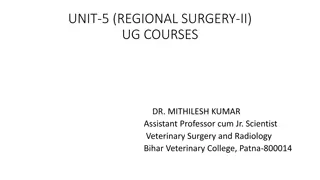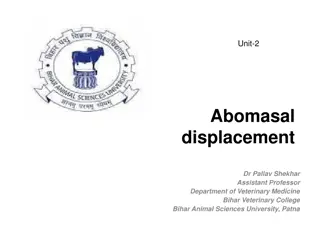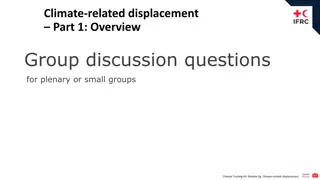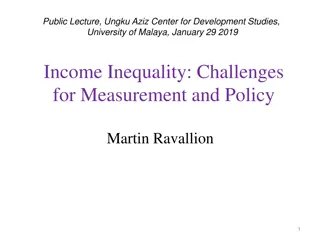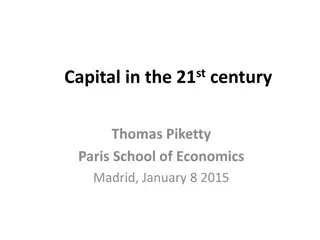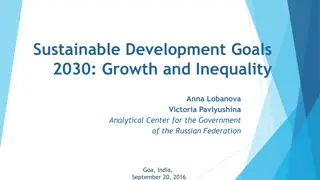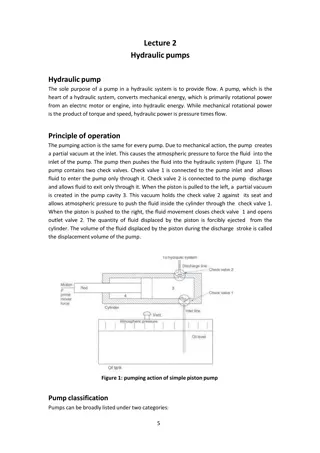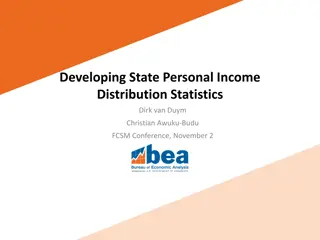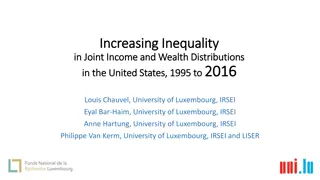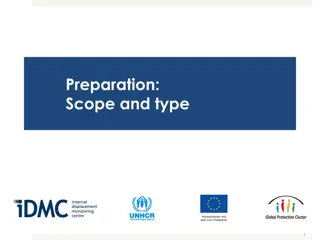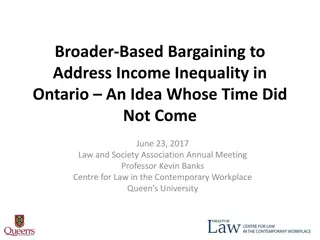Insights into Worker Displacement and Income Inequality in Ireland
Exploring the impact of worker displacement, job flows, and income inequality in Ireland using job churn data from Ms. Nírín McCarthy, School of Economics, University College Cork. The study focuses on the effects of displacement on workers' earnings, employment earnings inequality, and job flows within the Irish labor market. It examines the dramatic changes in the Irish economy, including the increase in unemployment rates and the subsequent earnings losses of displaced workers. The research employs methodologies such as propensity score matching to analyze the relationship between displacement events and earnings outcomes.
Download Presentation

Please find below an Image/Link to download the presentation.
The content on the website is provided AS IS for your information and personal use only. It may not be sold, licensed, or shared on other websites without obtaining consent from the author.If you encounter any issues during the download, it is possible that the publisher has removed the file from their server.
You are allowed to download the files provided on this website for personal or commercial use, subject to the condition that they are used lawfully. All files are the property of their respective owners.
The content on the website is provided AS IS for your information and personal use only. It may not be sold, licensed, or shared on other websites without obtaining consent from the author.
E N D
Presentation Transcript
Insights into worker displacement, job flows and income inequality in Ireland using job churn data Ms. N ir n McCarthy School of Economics, University College Cork
Job churn data & Research areas The impact of displacement on the earnings of workers in Ireland Employment earnings inequality in Ireland Job flows in the Irish labour market
The impact of displacement on the earnings of workers in Ireland
The impact of displacement on the earnings of workers in Ireland Dramatic changes in the Irish economy Increase in the unemployment rate - 14% in 2011 Slow down in economic growth Many workers became displaced from their employers Firm closure Mass Layoff Issues Earnings losses of displaced workers. How firm-based and person-based characteristics are related to earnings losses of displaced workers. How does the industry a displaced worker finds re-employment in impact on their earnings?
The impact of displacement on the earnings of workers in Ireland Year Relative Cohort Person Firm id 22 22 22 . . . . Displaced Pay Age Gender Nationality NACE sector F F F . . . . time -2 -1 0 1 2 3 4 id 6 6 6 6 6 6 6 2005 2006 2007 2008 2009 2010 2011 2007 2007 2007 2007 2007 2007 2007 1 1 1 1 1 1 1 50000 36 51000 37 52000 38 . . . . M M M M M M M IRE IRE IRE IRE IRE IRE IRE 39 40 41 42
The impact of displacement on the earnings of workers in Ireland Methodology Propensity score matching Displaced individuals matched with non-displaced individuals with similar propensity to be displaced. A probit model is used; Nearest Neighbour matching, Without replacement, Caliper to ensure the closeness of the matches. Common Support & Balancing tests performed.
The impact of displacement on the earnings of workers in Ireland - Some findings The numbers displaced (matched), 2005-2010 Year Closure event Mass-Layoff event 2005 10,221 11,260 2006 14,120 13,603 2007 20,516 10,059 2008 45,258 38,723 2009 32,452 21,724 2010 29,963 13,075
The impact of displacement on the earnings of workers in Ireland - Some findings The Probability of Employment (b) Mass Layoff (a) Closure 1 1 Probability of Employment Probability of Employment .8 .8 .6 .6 .4 .4 .2 .2 -4 -3 -2 -1 0 Relative Time 1 2 3 4 5 6 -4 -3 -2 -1 0 Relative Time 1 2 3 4 5 6 Displaced Non-displaced Displaced Non-displaced
The impact of displacement on the earnings of workers in Ireland - Some findings The Probability of Employment of displaced 26-35 year olds and displaced 56-64 year olds (a) Closure (b) Mass Layoff 1 1 Probability of Employment Probability of Employment .8 .8 .6 .6 .4 .4 .2 .2 -4 -3 -2 -1 0 Relative Time 1 2 3 4 5 6 -4 -3 -2 -1 0 Relative Time 1 2 3 4 5 6 Displaced 26-35years Displaced 56-64years Displaced 26-35years Displaced 56-64years
The impact of displacement on the earnings of workers in Ireland - Some findings The Earnings losses of displaced workers (a) Closure (b) Mass Layoff 0 0 -5000 -5000 Earnings losses Earnings losses -10000 -10000 -15000 -15000 -20000 -20000 -4 -3 -2 -1 0 Relative Time 1 2 3 4 5 6 -4 -3 -2 -1 0 Relative Time 1 2 3 4 5 6 All cohorts upper/lower All cohorts upper/lower
The impact of displacement on the earnings of workers in Ireland - Some findings The Earnings losses of displaced workers pre and post 2008 (a) Closure (b) Mass Layoff 0 0 -5000 -5000 -10000 -10000 Earnings Earnings -15000 -15000 -20000 -20000 -5 -4 -3 -2 -1 0 1 2 3 4 5 6 -5 -4 -3 -2 -1 0 1 2 3 4 5 6 Relative Time Relative Time 2005/2006/2007 cohort 2008/2009/2010 cohort 2005/2006/2007 cohort 2008/2009/2010 cohort
The impact of displacement on the earnings of workers in Ireland - Some findings Displacement increased over the period in question. It appears that those displaced due to mass-layoff are more adversely impacted. Other areas under investigation The role of nationality and earnings losses. Those who switch versus stay in the same industry following displacement and earnings losses.
Employment earnings inequality in Ireland
Employment earnings inequality in Ireland Why study income inequality? Wilkinson and Pickett (2010) contend that countries with higher levels of income inequality are more likely to also suffer from a wide range of social problems including: poorer educational achievement lower life expectancy and other inferior health outcomes higher levels of violence and crime
Employment earnings inequality in Ireland Job churn data Sample of 1,406,901 individuals. All individuals have a P35 return submitted for all years in the study. Measuring earnings inequality: The Gini Coefficient.
Employment earnings inequality in Ireland Some Findings Median Pay (including by gender) for the period 2006 to 2010 40,000 35,000 30,000 25,000 Total 20,000 Male Female 15,000 10,000 5,000 0 2006 2007 2008 2009 2010
Employment earnings inequality in Ireland Some Findings Male/Female Earnings Differential (2006 to 2010) 12,000 50% 45% 10,000 40% 35% 8,000 30% 6,000 25% 20% 4,000 15% 10% 2,000 5% 0 0% 2006 9,606 44% 2007 9,740 40% 2008 9,680 37% 2009 8,065 31% 2010 7,173 28% Pay Difference As a % of Female Median pay
Employment earnings inequality in Ireland Some Findings Earnings Inequality (including by gender) from 2006 to 2010 0.41 0.40 0.39 0.38 0.37 0.36 0.35 0.34 0.33 0.32 2006 0.40 0.38 0.39 2007 0.37 0.35 0.36 2008 0.36 0.35 0.36 2009 0.37 0.36 0.36 2010 0.38 0.38 0.37 Total Male Female
Employment earnings inequality in Ireland Some Findings Median Pay by Earnings Quintile
Implications For those in employment throughout the period median, earnings increased to 2008 and fell (by a smaller amount) from 2008 to 2010. The economic recession in Ireland has led to increased employment income inequality among individuals. A gender pay gap exists in Ireland but has diminished over the study period. Very few individuals see a dramatic change (move of more than one quintile) in their quintile position.
Job flows & the Irish labour market
Job flows & the Irish labour market Other area of investigation The relationship between international trade and job creation and job destruction rates. How? Link to Census of Industrial Production data. Preliminary Findings Those who did engage in some exporting or importing activity had higher mean employment. The employment growth rate was negative over the period 2008-2010, it is less negative for exporters compared to non-exporters.
Acknowledgements I would like to acknowledge the support of my PhD supervisor Prof. Peter Wright, Economics Department, University of Sheffield. I would also like to acknowledge the support of PublicPolciy.ie who funded the study on Employment earnings inequality in Ireland as well as co-authors Ms. Marie O Connor, Dr. Meadhbh Sherman and Dr. Declan Jordan, School of Economics, University College Cork.
Thank you for your attention Ms N ir n McCarthy, School of Economics, UCC Email: noirin.mccarthy@ucc.ie







